In the 1990’s, one organization dedicated a decade of work to gain FDA approval of a drug that promised to revolutionize abortion in America. Shoe Leather: the Abortion Pill follows the Population Council’s effort to bring mifepristone – and medical abortion – to the United States. Three decades later, we’ll relive the fight alongside those who were in the center of the ring and explore why some are still waiting for that revolution to arrive.
Transcript
LAUREN MASCARENHAS:
Most adults today remember where they were when the twin towers came down. It consumed the news for weeks.
Archive in
MALE REPORTER: The twin towers of the World Trade Center, both of them being damaged by impacts from planes.
LM:
Maybe even months.
MALE REPORTER:Just moments ago, so maybe 18 minute after the first impact, the second tower was impact with a, by another
LM:
I was seven. I remember watching the coverage on TV before I went to school,
MALE ON PHONE: The plane just was coming in low, and the wing tips tilted back and forth and then it flattened out. It looks like it hit at a slight angle in the World Trade Center.
Archive out
LM:
And I didn’t totally understand what was happening but I knew it was bad.
ABIGAIL BRONE:
And I was three. I remember, growing up in Connecticut, everyone was really worried that we were next. I knew people who worked in the city. I knew people who lived in the city. It was a really crazy time.
I remember when I was older hearing stories about my uncle who lives right outside the city but works in Manhattan coming home from work hours late, covered in soot.
Life hasn’t come to a halt that way since, until… right now.
Archive in
SAVANNAH GUTHRIE
The latest on the coronavirus pandemic as we start this morning confirmed case in this country have risen to nearly 995,000
LESTER HOLT
Good evening everyone, ready or not, and with nearly 1 million confirmed covid-19 cases in the us since the start of this outbreak, parts of America are moving on tonight.
Archive out
LM:
The Coronavirus crisis disrupted our reporting, and drove us out of New York City. Stay-at-home orders have been implemented around the country.
As headline after headline about new cases, medical equipment shortages and deaths roll in, it’s all too easy to miss what else is happening.
Experts say that the social isolation and economic collapse caused by COVID-19 will likely lead to more unintended pregnancies.
Several states have recently deemed abortion as a nonessential medical service during the pandemic. This could effectively halt abortion access for women living in those states…
AB:
But it doesn’t have to.
Theme music in
Nearly 30 years ago, one organization dedicated a decade of work to gain FDA approval of a pill that promised to revolutionize abortion in America.
LM:
I’m Lauren Mascarenhas.
AB:
And I’m Abigail Brone. This is Shoe Leather, an investigative podcast that digs up stories from New York City’s past – to find out how yesterday’s news affects us today.
LM:
This is season 1, New York in the 90s. The Abortion Pill.
Theme music out
Archive in
CLINTON: We have to remind the American people once again that being pro-choice is very different from being pro-abortion.
WITI REPORTER: Their target today was the clinic at 26th and Wisconsin, which was surrounded by pro-choice demonstrators. 71 people were arrested, 43 of them children. Both sides claim victory and promised even larger turnouts at the protest planned for this Saturday.
Archive out
AB:
In the early 90’s abortion had been legal in the United States for nearly 20 years.
Bill Clinton was just elected president,
CLINTON (acceptance speech): On this day with high hopes and brave hearts and massive numbers, the American people have voted to make a new beginning.
LM:
And women in America were asserting their independence and autonomy like never before.
Archive in
SPICE GIRLS (Wannabe): I’ll tell you what I want, what I really, really want. So tell me what you want, what you really, really want.
LM:
The Spice Girls were urging women to get what they want.
BEAT, bring music up
LM:
And so were leaders around the nation.
RBG (swearing in): Times are changing. The president made that clear by appointing me, and just last week naming five other women to Article III courts. Six of his total of 14 federal bench nominees thus far are women.
BARBARA A. MIKULSKI: I’m here as the first democratic woman ever elected to the United States Senate in her own right… This is the year of the woman, because this is the year of change.
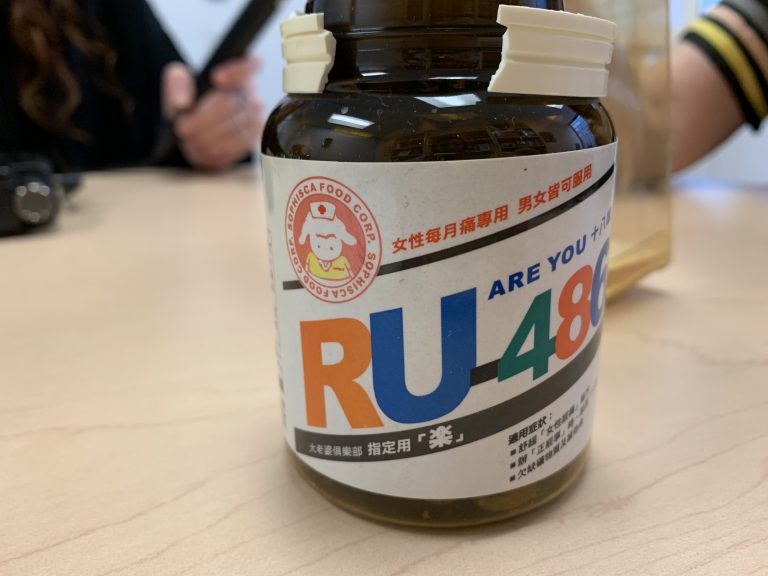
Archive out
AB:
Enter RU – 486. Also known as, the abortion pill.
Archive in
C-SPAN HOST: RU-486 is a drug that can end pregnancy in the first 9 weeks…To date Great Britain and France have approved the drug for general use. So far Ru-486 is not available in the United States.
Archive out
LM:
But that was about to change – RU – 486 would cause a decade of legal and cultural upheaval. And the people behind it – the ones who fought so long for its FDA approval – were forever impacted by the fight.
SANDY ARNOLD: There were a lot of people who were afraid. Either afraid for their lives or afraid for their reputations.
BEAT
SANDY: My sense was if they’re gonna shoot me, they’re gonna shoot me.
Music in
AB:
In 1989 the french drug manufacturer, Roussel Uclaf, introduced RU-486 – also known as mifepristone – in France.
Mifepristone was introduced as an alternative to surgical abortion for women early in their pregnancy. It’s noninvasive – safer, more private and most importantly, more accessible.
Mifepristone terminates a pregnancy. It’s followed by a prostaglandin, a type of drug that expels the embryo. This process is now known as a medical abortion.
Music out
BEAT
CLINTON: Here in the United States RU-486 has been held hostage to politics.
LM:
Bill Clinton campaigned on the promise of bringing the abortion pill to American women.
Eager to secure a second term, he acted immediately to make good on that promise.
AB:
On January 22, 1993, just two days after being sworn into office, Clinton wrote a memo to the secretary of Health and Human services. He urged the agency to work with the FDA to explore the testing, licensing and manufacturing of mifepristone.
CLINTON: It is time to learn the truth about what the health and safety risks of the drug really are.
BEVERLY WINIKOFF: When Bill Clinton became president, and one of the promises of his campaign was to bring this to the American women. Because it was a big thing like why can French women have this and American women can’t?
Music in
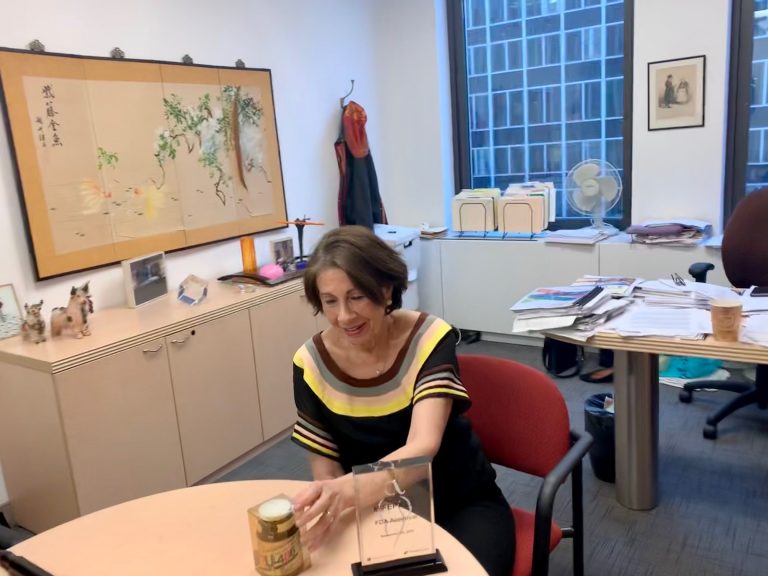
AB:
Beverly Winikoff sits at a conference table in her office in Midtown, Manhattan. Piles of paper and post it notes line the desk behind her. She’s rocking bright pink lipstick and pearl earrings. She’s petite, well put together, with a short brown bob. She’s 74 years old, and looks a little like Nancy Pelosi, actually.
LM:
Back in the 90s Beverly worked for the Population Council. It’s a nonprofit organization, focused on conducting global research and advocacy around health issues. The council worked on HIV prevention and increasing access to birth control. It placed a big emphasis on empowering girls and women to have a say in their own health.
Beverly was the Council’s Program Director for Reproductive Health. She says mifepristone was so controversial at the time, even its creators no longer wanted a hand in its advancement.
BEVERLY: What happened first is, it was registered in France and then it was registered in the United Kingdom and in Sweden and
Music Out
BEVERLY: Then Roussel said no more because it was too controversial. And they were getting too much kind of threatening mail and they just didn’t, you know companies are very averse to that kind of thing. So they decided, no more, you can’t, we’re not going to register anywhere else. We’re done.
LM:
But Clinton was persistent. He urged Roussel to bring the pill to the states.
The company agreed to sign over the patent rights, but it declined to be the drug’s manufacturer in America. The abortion debate was getting dangerous.
Archive in
FEMALE REPORTER 1: An abortion facility was hit by a bomb blast.
MALE REPORTER 1: Bomb blasts at three abortion clinincs.
MALE REPORTER 2: A propane gas bomb exploded last night at the Washington office of the national abortion federation. So far this year 28 abortion clinincs and information centers have been bombed or set afire.
MALE REPORTER 3: Dr. David Gunn was shot after getting out of his car as he came to work at a pensicola abortion clinic.
FEMALE REPORTER 2: The gunman shot 4 people before escaping here. One woman, a clinic worker, died at the scene.
Archive out
BEAT
AB:
The pill needed a sponsor for FDA approval – one that was willing to weather the controversy. Roussel turned to the Population Council.
After lengthy negotiations and pressure from the Clinton administration, Roussel Uclaf signed the patent rights to mifepristone over to the Population Council in 1994.
The Population Council, Clinton assured them, would handle everything from there.
BEAT
AB:
It was no small task for the Pop Council…… , but expanding access to birth control was in line with their mission. And with an issue as politically polarizing as abortion, if there was ever a time to get this done, it was now – before Clinton left office.
LM:
The Population Council had its work cut out…it had to manage its relationship with the FDA, and organize clinical trials…
BEVERLY: And do them and analyze them and present them in proper format to the FDA and negotiate the label and the conditions of distribution. So all of that was, you know, one stream, but then they also had to deal with the politics, right?
AB:
In addition to a sponsor, a drug needs a distributor to gain FDA approval. And that was tough because few companies were willing to commercialize a drug that had anything to do with abortion.
Because of the controversy surrounding mifepristone, the Population Council kept this distributor a secret throughout the process.
LM:
We now know that company was Danco Laboratories. It was created for the sole purpose of marketing and distributing mifepristone.
AB:
Richard Hausknecht was a founder of Danco Laboratories. He died in 2008, but he recorded an oral history about his life back in 2001. This is what he had to say about mifepristone.
RICHARD HAUSKNECHT: I really wasn’t very much involved in abortion during the late 70s and early 80s, except in terms of my own private practice, but as I saw the increasing utilization of mifepristone in Europe, and the fact that we couldn’t have it here really infuriated me.
I shared a research bench when I was getting my fellowship at Columbia with a man named Etienne Baulieu, who was the man who eventually put together the steroid known as mifepristone, which is RU-486.
I didn’t think this drug was going to work.
Music in
Boy was I wrong. I turned down the opportunity to participate in the original research on mifepristone. One of the big mistakes of my life.
Music fade out
LM:
Almost 15 years after first learning about mifepristone, Hausknecht dedicated himself to making it available in the United States. Others had tried before, but were unable to get the pill approved.
HAUSKNECHT: Finally, in 1994 I said to myself one day enough, this is wrong. And with this got to be another way to deal with this issue.
Nobody was accomplishing anything, they were doing but not accomplishing anything in terms of making medical abortion available in the United States.
AB:
Hausknecht, along with three colleagues, founded Danco Labs in 1994. With them on board, the Population Council was ready for one of the most important steps in the FDA approval process – clinical trials.
Beverly was one of the council members in charge of the trials. In addition to the way their bodies reacted to the pill, she was interested in the women’s overall experience – how painful it was for them, the problems they encountered and how they recovered.
These findings would eventually be presented to an FDA advisory committee, which would play a big hand in deciding the fate of mifepristone.
BEAT
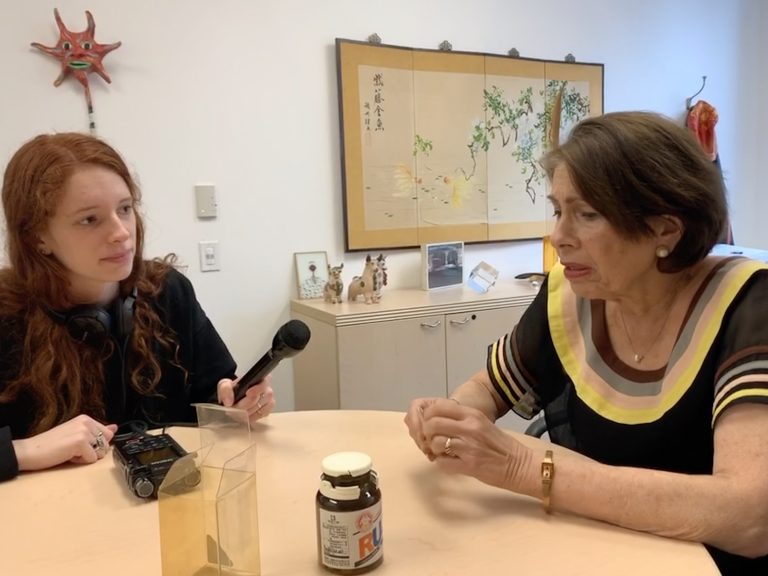
BEVERLY: Abortion – what was an abortion was redefined….
Before, it was you get anesthesia, you’re lying on a table, somebody is putting stuff inside you. Here – nothing like that. You go to a clinic, you have an outpatient appointment, you take some pills home and you have your abortion.
LM:
Did you have an awareness, personally, that you were part of something big?
BEVERLY: It felt like a very big deal to me, because I was so invested in it, not because I thought everybody else would think it was a big deal, but I knew it was a big deal. Because it felt like this was something important.
MUSIC
LM:
The Population Council conducted research and clinical trials. They also faced an onslaught of opposition that played out both in the courts and the media… sometimes even with picket signs outside of their office building.
SANDY ARNOLD: As you know, it was um… say a risky proposition at that point in time.
AB:
That’s Sandy Arnold. She was the Population Council’s Vice President of Corporate Affairs in the 90s. She oversaw public relations, managed the council’s relationship with the FDA, and fielded the many, many legal threats mounted against the organization. She was acutely aware of the intensity of opposition they faced.
SANDY: I was told that I had FBI agents attached to me… they were concerned that somebody would come after me.
It was certainly intimidating for some, not for me. I was very gutsy throughout this thing. My sense was if they’re gonna shoot me, they’re gonna shoot me. You know? I don’t know why I was that gutsy. My life has not been characterized by being out there in any way. But I had just decided that this was an important thing, and I could do it.
LM:
The Pop Council members were ordinary people, taking on an extraordinary task.
SANDY: They had to be gutsy. They had to really believe in what they were doing. And if they didn’t, they didn’t last long. Well, because there was a risk, and you never knew where it was going to come from.
LM:
By the summer of 1996, the time had come for an FDA advisory committee to meet and decide whether to recommend mifepristone for marketing in the U.S. Advisory committees don’t make the final decision, BUT the Pop Council knew that securing a recommendation, all but guaranteed eventual FDA approval.
AB:
Beverly gathered her team’s findings to present to the committee at the July 19 hearing. This was the moment the Population Council staff had been preparing years for. They were confident in the data – more than 2,000 women had taken part in clinical trials. The drug worked and it was safe.
BEVERLY: We were somewhat apprehensive about whether there are people on the committee who are going to give us a hard time because of political things, but not not because of the data. Not because of the science.
AB:
What happened next was a little like a scene from a spy movie.
Spy movie music in
LM:
Beverly remembers being picked up by a bus from her hotel somewhere in suburban Maryland, where police patrolled the lobby. She was driven to a secret location.
She remembers being ushered through a tent in the middle of a field. There was a blockade of Federal marshals and police officers guarding the event.
Spy music out
LM:
George Brown, the Vice President of the Population Council at the time, still remembers the scene.
GEORGE BROWN: It was quite heavily secured…I mean… in the days before 9/11, it was quite remarkable, of course, after 9/11 those things became more common, but it was just a very, very tense atmosphere. And very secure.
AB:
If this sounds dramatic for an FDA approval hearing, it’s because it was. It was also necessary. Public advisory committee hearings are typically only made private if the conversations involve trade secrets. There have been few other instances where a hearing required this level of security, but the safety concerns were legitimate.
SANDY: Everywhere along the road, it was handled with a great deal of sensitivity to the fact that it was a political time bomb.
LM:
Sandy Arnold spoke at the hearing. There were 33 speakers total, from both sides of the abortion debate, including the Feminist Majority Foundation and American Victims of Abortion.
The audience was largely female. The advisory committee was made up of doctors, specialists and scientists.
Their job was to decide whether the drug was safe based on the data from the clinical trials and make a recommendation to the FDA.
FDA SOURCE: I have to be honest. I have some family members who don’t even know about the work I’ve been doing.
AB:
That was one of the senior medical reviewers at the FDA. He doesn’t want his name revealed. He understands the threat that comes with any work related to abortion. He’s worried about his safety and privacy.
FDA SOURCE: The controversy, clearly, in my opinion, was not the safety or efficacy of the drug. It’s just on the entire issue of abortion period… But the FDA, strictly speaking, doesn’t approve a drug or not approve a drug based on issues such as the controversy of pro life, pro choice
LM:
He’s never spoken to the media before about his work with mifepristone.
In fact the names of the FDA staff involved with mifepristone have never been released.
FDA SOURCE: It’s definitely not standard. It’s not routine, you can look up almost every other drug that I was the primary medical officer for and my name would appear right there on the review.
LM:
And we did – his name is listed on at least eight other FDA drug reviews. But no staff names are listed on the review of mifepristone.
AB:
By the next day, the advisory committee announced its decision. It recommended the FDA approve mifepristone. The FDA commissioner said he hoped the agency would have a decision by September of that year.
Beverly and the Population Council were cautiously optimistic. They had completed their biggest challenge yet, but they still had work to do. Beverly and her team went back to New York and continued clinical trials in the U.S. and Canada.
LM:
It was another four years before the FDA announced its decision. On September 28, 2000, the Population Council got word that mifepristone was approved. Clinton addressed the approval at a cabinet meeting later that day.
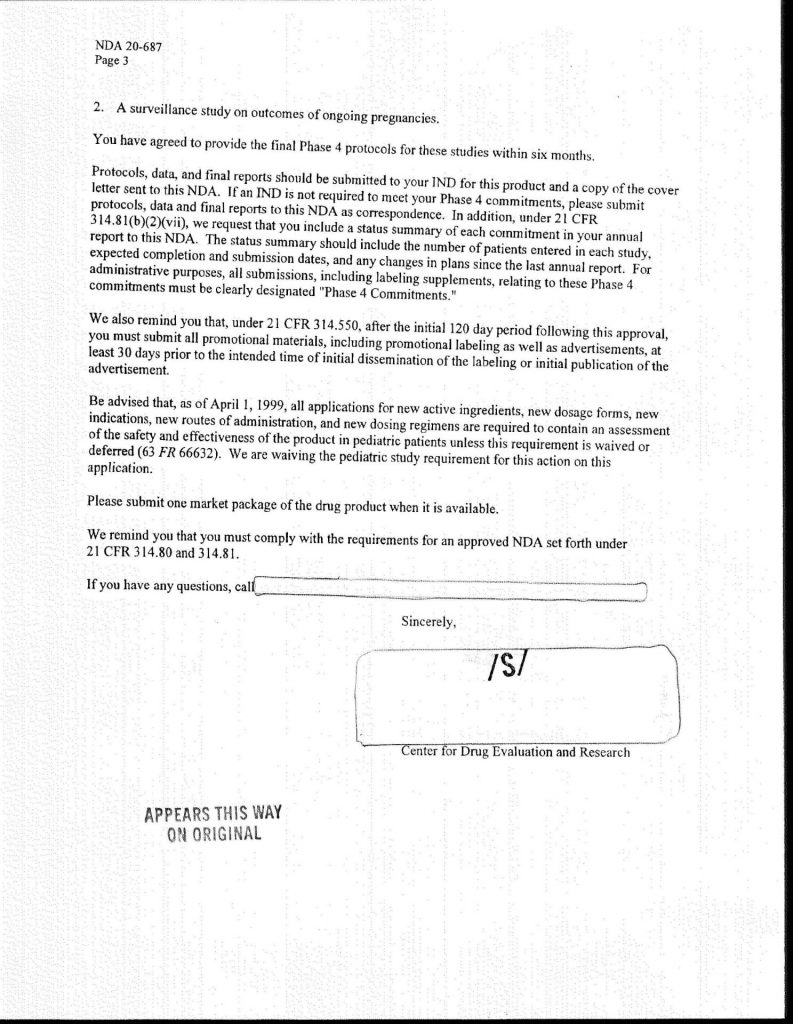
FDA approval letter, page 1 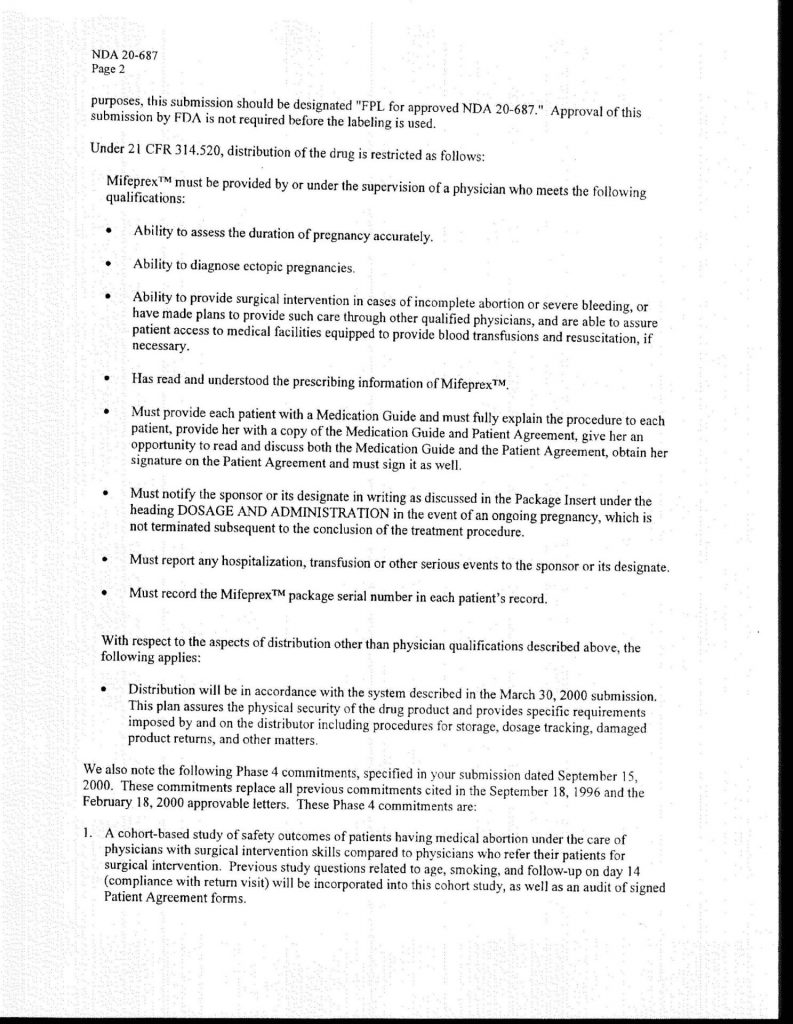
FDA approval letter, page 2 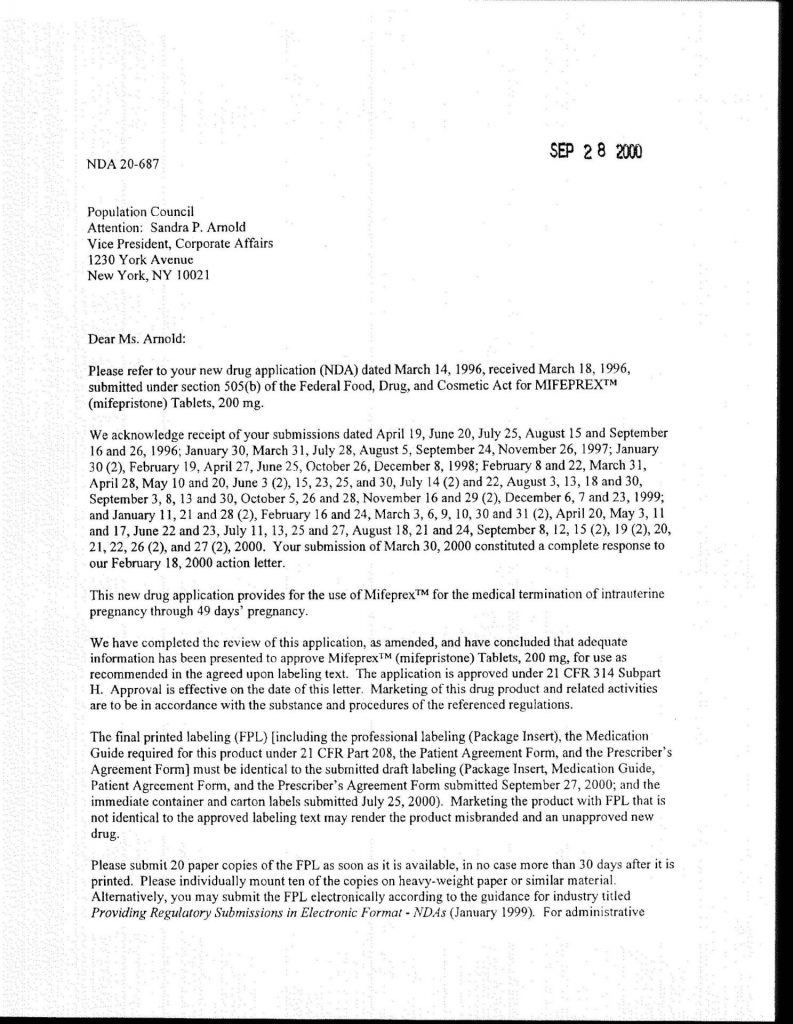
FDA approval letter, page 3
CLINTON: I think they bent over backwards to do a lot of serious inquiries…I regret that some members of the other party have already tried to politicize it…We should respect the fact that it took so long to make sure they were making a good decision.
AB:
It was a victory – for Clinton, Danco and the Population Council. Not to mention, the women across America who now had access to medical abortion.
LM:
There’s a plaque sitting on a bookshelf in Beverly’s office, commemorating the date of mifepristone’s approval.
AB: I see your plaque down here.
LM: FDA approval, yeah-
BEVERLY: Oh really? Yeah…
AB: Does everyone get like plaques like this whenever a drug is approved? Or was it like hooray?
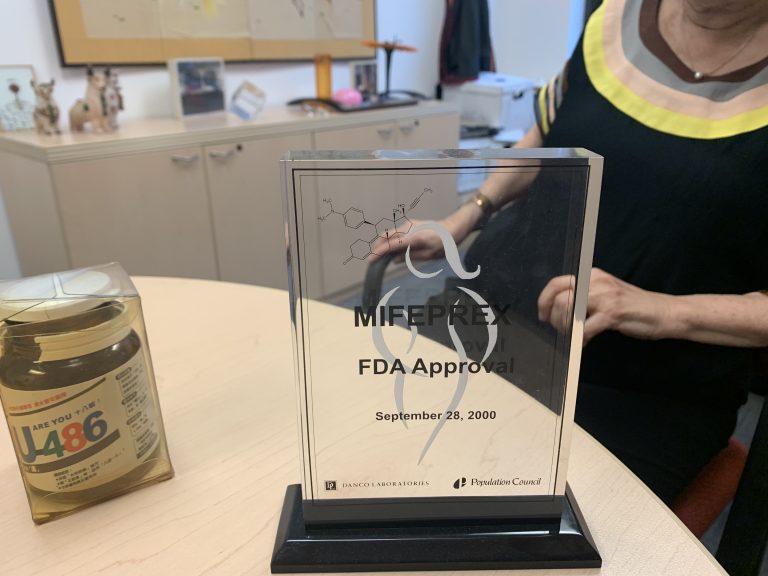
BEVERLY: No, no it was just such a long story, right?
LM:
The date on that plaque – September 28 – just happens to be international safe abortion day.
AB:
The FDA approved the abortion pill. But they said the drug could only be prescribed by healthcare providers who meet certain requirements, meaning women would still have to go into a clinic for a consultation and many would still have to go somewhere outside of their primary care provider.
LM:
Less than a year after the FDA approved mifepristone, a turn of events threatened the future of the drug. In 2001, Clinical trials were still underway in Canada.
BEVERLY: I remember the first day we heard about a death.
BEAT and Ominous music
AB:
After years of studies and clinical trials and an FDA approval – the abortion pill was now connected to the death of a woman in Canada.
BEAT
BEVERLY: So it was September 10 2001. There was a death reported.
AB: The day before 9/11.
Archive in
FEMALE REPORTER: We have unconfirmed reports this morning that a plane has crashed into one of the towers of the world trade center.
Archive out
BEVERLY: Yes, and that’s what saved mifepristone.
LM:…because nobody heard about it.
AB:…because everyone was focused on 9/11.
Archive in
MALE REPORTER: I just witnessed a plane that appeared to be cruising slightly lower than normal altitude over New York City. It hit directly in the middle of one of the World Trade Center towers.
Archive out
BEVERLY: It was in the newspapers if you go to the back pages.
BEAT
BEVERLY: Well it was one death versus 3,000.
BEAT
LM:
The woman in the clinical trial died on September 1, 2001. But the news was set to come out right before the 9/11 attacks.
One of the only articles we could find about the death was in the Toronto newspaper The Globe and Mail from September 20, 2001.
BEVERLY: And that was like, existential, like, Oh my God. What is going on? And is this going to be a problem. And, and so and Planned Parenthood was very worried and was thinking of taking it out of its clinics. And this was after it was registered.
LM:
The Population Council ran studies to figure out what was going on. The FDA and Centers for Disease Control, looked into it too.
AB:
It was determined shortly after, the cause of death was actually a bacteria – clostridium sordellii, or C. sordellii.
C. sordellii can be found in the gastrointestinal tract and vagina of healthy people. The bacteria can become infectious following childbirth, and other procedures, like abortions. The infections create toxic shock and usually prove fatal.
In the early years after mifepristone was approved, a few women died due to C. sordellii, but the deaths weren’t tied to the pill itself.
BEVERLY: Finally the FDA and the CDC concluded that it was not dangerous – that it was not something that you could tie directly to mifepristone.
BEAT
LM:
Mifepristone had weathered the storm. But there was still more work to be done.
The council was now under new leadership… and so was the country.
GEORGE: Bush had stepped on the scene. So it was under the Bush era where things got less encouraging in Washington than they had been under the Clinton years.
LM:
George Brown saw the Pop Council’s agenda adapt in real time.
GEORGE: So that was a more important change than the change of council presidency was the change in the United States presidency.
AB:
The Population Council had won the fight for FDA approval, but they were hesitant to step back into the ring in this newly conservative political environment. Beverly began to feel constrained in her work around medical abortion.
BEVERLY:…so really, it was medical abortion that actually made me leave the Pop Council.
BEAT
GEORGE: Beverly, negotiated a departure – very cleverly for her – I think to leave the council and take most of their abortion work with her. And including some of the funding – a very astute move on her part, I think.
LM:
In 2003, Beverly founded Gynuity Health Projects. The organization makes advances in the science of reproductive and maternal health, and then advocates to make those advances available to people around the globe.
AB:
Gynuity took the momentum the Pop Council created with medical abortion and ran with it. It expanded the use of mifepristone and conducted research to answer questions about its safety.
GEORGE: Gynuity has carried on the sort of research that the council might have done if that the whole portfolio had remained within the council.
Music in
Archive in
FEMALE REPORTER: The World Health Organization declared the outbreak an international public health emergency.
MALE REPORTER 1: There is now going to be a statewide stay-at-home order.
MALE REPORTER 2: Need to learn to live in a world with the coronavirus.
Archive out
LM:
Like much of the world right now, New York City is quiet
But Beverly Winikoff is sitting in her empty office, working.
BEVERLY: Funny to walk on the streets. There are four people on the street from Second Avenue to Park Avenue on 42nd Street.
Music out
LM:
Once again, Beverly has found herself on the front lines of women’s reproductive health.
AB:
People across the country are currently under stay at home orders. Women have arguably never had less access to abortion than they do in this moment. Pro-choice advocates are supporting telabortion – a medical abortion where a doctor consults with a woman remotely and the abortion pill is mailed to her.
LM:
In 2016, Beverly’s company, Gynuity launched a telabortion study, which has expanded to 13 states. Almost 800 women have used the service to date. Gynuity has seen an uptick in inquiries since the pandemic began.
AB:
Nearly 40% of all abortions in the U.S. in 2017 were medical abortions
It’s been twenty years since the FDA approved mifepristone and a lot has changed since the Population Council took up the fight.
LM:
Nearly three decades later, that little pill that promised to revolutionize abortion in America, might just be on its way
Theme music in
AB:
Shoe Leather is a production of the Columbia Graduate School of Journalism. This episode was reported, written and produced by me, Abigail Brone.
LM:
And me, Lauren Mascarenhas. Joanne Faryon is our executive producer and professor. Dale Maharidge is our co-professor. Keshav Pandya is our technical advisor.
AB:
Special thanks to Columbia Journalism Librarian Kristina Williams, Columbia Digital Librarian Michelle Wilson, Peter Leonard from Gimlet Media, Rachel Quester from The Daily, Emily Martinez and David Blum from Audible, Susan White from Garage Media, Nate Di Meo [De M-eye Oh] from The Memory Palace, Jonathan Hirsch from Neon Hum Media, Clint Schaff from the LA Times Studios, Madeleine Baran and Samara Freemark from American Public Media, In the Dark and to Stuart Karle for his legal advice.
LM:
For more about this episode and Shoe Leather, go to our website shoeleather.org. To stay up to date on the latest Shoe Leather happenings, follow us on social media. We are on facebook at facebook.com/ShoeLeatherCast and on instagram and twitter @ShoeLeatherCast.
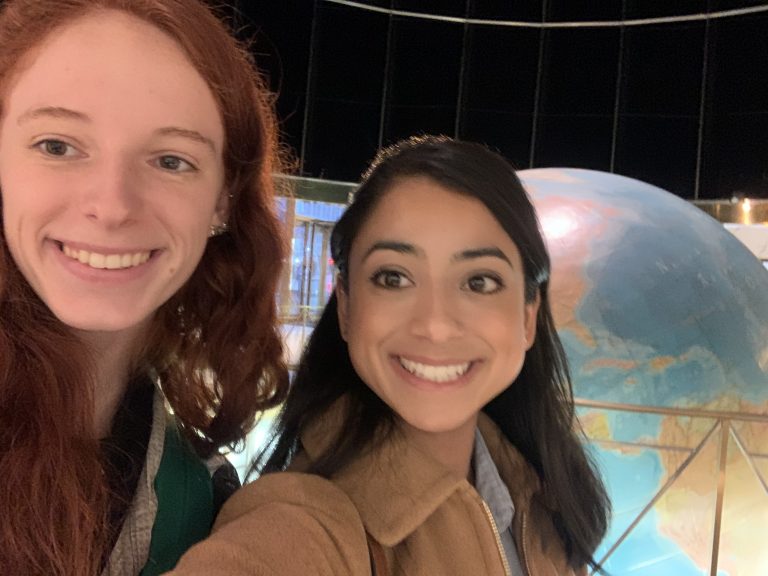
Shoe Leather’s theme music – ‘Squeegees’ – by Ben Lewis, Doron Zounes and Camille Miller. Other Music by Blue Dot Sessions.
Music out
© Lauren Mascarenhas and Abigail Brone, 2020
To contact the authors of this podcast, please reach out by email at lauren.m@columbia.edu and akb2210@columbia.edu.
